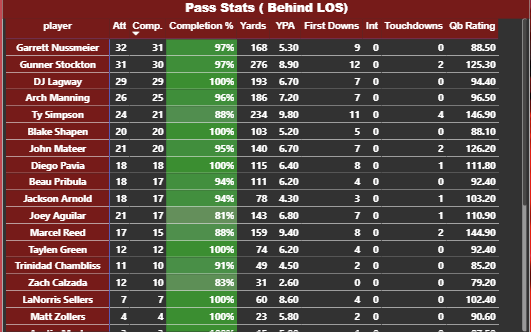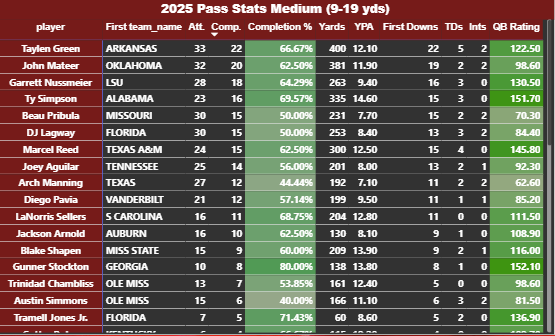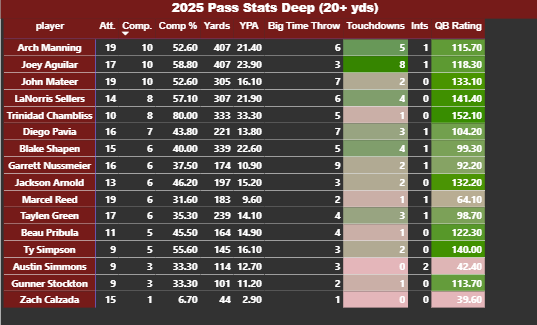The bye week is here, and I’m not going to lie—it’s much needed. The last month has been a blast, but a breather before OU’s schedule cranks to eleven will do us good. After three tailgates, ten podcasts, one sick kiddo, and a busted dashboard that needs TLC, I’m ready to exhale, get some R&R, and empty the notebook before the most defining stretch of our season begins.
For today, buckle up. It’s a long one, and it’s been a long time coming.
Let’s talk about someone we haven’t mentioned at all…
The. John. Mateer. (Part 1)
Oklahoma asked John Mateer to take the keys to a brand new offense in a brand new league. (for Ben and him) Four weeks in, the data says he is doing more than keeping the Sooners on schedule — he is shaping the way they win.
Mateer is not posting the most eye-popping raw totals in the SEC — that honor currently sits with Arkansas’ Taylen Green — but Oklahoma’s junior has assembled one of the most complete, multi level passing profiles in the country. From the quick game to intermediate strikes to calculated shots, his efficiency and decision-making fit exactly what this scheme needs.
Let’s break Mateer’s game into several layers.
Layer 1: The layups are automatic
Behind the line of scrimmage, Mateer is essentially mistake proof: 95% completions (20 of 21) for 140 yards and a 126.2 passer rating. Those throws function as Oklahoma’s perimeter run game, extending the field horizontally, stealing first downs and setting up tempo. It is also a window into Mateer’s temperament — take what is there, keep the offense on schedule, then hunt.
The short area (0–9 yards) tells the same story. He is among the volume leaders with about 60 attempts, 46 completions (about 77%) and efficient yardage after the catch baked in. The Sooners’ quick game menu — RPO slants, stick, hitches and speed outs — has become a down to down engine.
We have to find a way to get easy yards with our backs…
Layer 2: The money zone is the difference
The intermediate band (9–19 yards) is where college games swing, and Mateer is thriving. He sits near the top nationally with about 381 yards on 30 attempts (about 62.5%) and a QB rating just shy of 100. These are chain moving throws — glance posts versus quarters, digs off play action, deep outs with NFL velocity — that flip field position and punish single high looks. It is also where his processing shows up; he is comfortable working high to low and throwing on time from the pocket.
Layer 3: Calculated aggression down the field
Explosives matter in the SEC, and Mateer’s deep ball profile checks the right boxes. He is among the top five in deep volume with double digit big time throws (7) and a passer rating in the 130s on passes 20 plus yards downfield. The flip side: three interceptions on those shots. That is the classic tradeoff for a quarterback who is willing to attack leverage. The staff can live with a few aggressive misses when the explosives stretch safeties and open up the run game.
Mateer and Arbuckle are unforgiving against man coverage. The passing identity is simple: take the shot with my athlete against yours, especially with Deion Burks. Now, after Auburn got a lesson, add Isaiah Sategna. The national conversation has not caught up to how big that one vertical win was. Oklahoma just put on tape that it has two wide receivers that win, and not only are the Sooners willing to throw it up, those wideouts are bringing it down in big moments. Every SEC defensive coordinator is thinking the same thing right now:
“surely they do not have two receivers who can do that.”
Deion Burks is already dictating coverage. Michigan tried Cover 2, and Auburn rolled into Cover 7 (match-coverage) to bracket him. Now Isaiah Sategna is winning over the top.
The impact is massive: Sategna, Lewis, and Kanak are cashing in on the attention Burks draws and punishing single coverage.
No defense on Oklahoma’s schedule has enough cornerbacks with the athletic profile to win consistently against this group when they are playing at this level. If you load resources to Burks, the others will beat you. If you do not, Burks will.
That’s the poison you pick.
John Mateer at a high level -
Zoom out, and the total picture is that of a mature operator:
142 attempts, 1,029 yards, 7.3 YPA
Accuracy% 74.8 | Comp% 67.6
First downs: 56 | TD to INT: 6 to 3
Average time to throw: 2.57s (decisive)
Drop rate: 4.0% (receivers helping)
Sacks: 3 (protection plus timing)
Turnover worthy plays: 4
Two things jump out. First, the time to throw figure fits Oklahoma’s identity: distribute, punish space, keep the negative plays down.
Only Sacks: 6 given up (≈4.1% sack rate on 148 dropbacks).
Second, the low sack count on meaningful volume signals real pocket feel and protection communication by the offensive line.
Context vs. the field
The SEC has a diverse QB class this season — Green piling up explosives at Arkansas, Garrett Nussmeier playing point guard for LSU, Arch Manning failing.
Mateer’s production value sits in the top half those archetypes. He is efficient enough in the quick game to live on schedule, productive enough in the intermediate to create first downs in bulk with 49 explosive plays through the air, and aggressive enough deep to force defensive coordinators out of comfort calls.
John Mateer is doing exactly what wins in the SEC and this moving the sticks. Through four weeks he’s produced 56 first downs, second in the league behind Arkansas’ Taylen Green, a reflection of his timing (2.57s average time to throw) and accuracy in the intermediate window. It’s not empty volume either: at 7.3 yards per attempt with 67.6% completions, Mateer keeps Oklahoma ahead of schedule and turns routine downs into drive extenders. That chain-moving profile is why the Sooners’ offense feels sustainable week to week.
The Cons
Stay in the pocket.
On last week’s Trench Warfare pod—and again during the Auburn game—Charlie nailed it: Mateer is leaving the pocket too often. When he bails early, he kills the concept before it has time to develop. The offensive line will not be perfect on every snap, but high-level quarterbacks feel when a pocket is truly failing and when to climb and reset. Right now, Mateer is showing some of last year’s habits.
Champion Standard’s “why.”
The real truth on playbook availability.
There is plenty of growth left in this offense. Mateer has been largely limited to seam throws within the verticals family. We are not particularly sharp yet with Y-Cross (Yankee in my notes) or Sail. At Washington State, flood concepts and wide zone were staples. I said emphatically that Wazzu was a weak-side flood team that used Yankee to flood from the weak side, and Mateer with Arbuckle was excellent at dictating easy throws off it. This year, our flood concepts and wide zone have not been as clean—and we are still winning. That is progress. There is a lot more this offense can add as those concepts come online.
I have not rewatched the full Auburn game yet, and I am not sure I need to. When I study tape, I always log the initial call—pass or run—and I did that with Washington State in the offseason. Last year, Mateer gained 339 rushing yards on pass calls out of 826 total rushing yards, so about 41% of his rushing production came on scrambles. The mainstream narrative said Ben Arbuckle was a fifty–fifty pass/run play caller; in reality it was closer to 60–40.
My theory: Mateer wants to be a pocket passer. Alex (@AKing_Evals) flagged a great example—a frenetic snap where he bounced around hunting for something to happen. In 2025 through four games, Mateer has 190 rushing yards, and by my charting roughly 23 of those yards are from scrambles. For perspective, through the first four weeks last year he had already logged 189 scramble yards on pass calls.
Mateer is extending plays to hunt shots downfield, but when the throw is not there the down dies and the drive stalls.
We forget he is only in his second year as a starter, in the toughest conference in college football. He has not developed that part in his game yet. He wants to use his legs; the film makes that obvious. He is trying to extend plays to create “play two.” But, he has not been coached to step up in the pocket.
There’s an edge to him that’s hard to define—and it’s tough to criticize a quarterback who just stacked 11 explosive plays against Auburn. With this defense behind him, plays simply materialize.
My opinion, strap in.
Mateer makes magic.
A dog is a dawg.
Mateer is hungry.
Let’s see if the dog can hunt.
Bottom line
You will win a lot of Saturdays with a quarterback who turns nothing into something.
That is John Mateer right now.
Please come find us at the Tailgate!
Support us with everything you got!
Like, Comment and Subscribe!
When you share this, the tailgate grows and the party keeps rolling. Send it to your fellow Sooner fans!
Thank you for reading!
Booooooomer!!
Rob
Coming Articles before Texas:
Defensive Coverage Menu , Mateer Coverages Weakness and Sark Offense..




